Digital Marketing Report: Amazon's Indian Market Expansion
VerifiedAdded on 2021/04/21
|15
|3434
|79
Report
AI Summary
This report provides a detailed analysis of Amazon's e-marketing strategies, focusing on its planned expansion into the Indian market with an online grocery store. It begins with an introduction and situational analysis, including a SWOT analysis and industry analysis of the e-commerce landscape in India. The report then delves into market projections, market and cost analysis, and segmentation strategies, outlining how Amazon plans to position itself in the marketplace. It explores customer acquisition techniques, including social media, SEO/SEM, and email marketing, and examines the use of various e-commerce tools. The report also covers branding, video marketing, and web-enabled supply chains, concluding with an overview of the scope and limitations of digital marketing in this context. References are included to support the analysis.
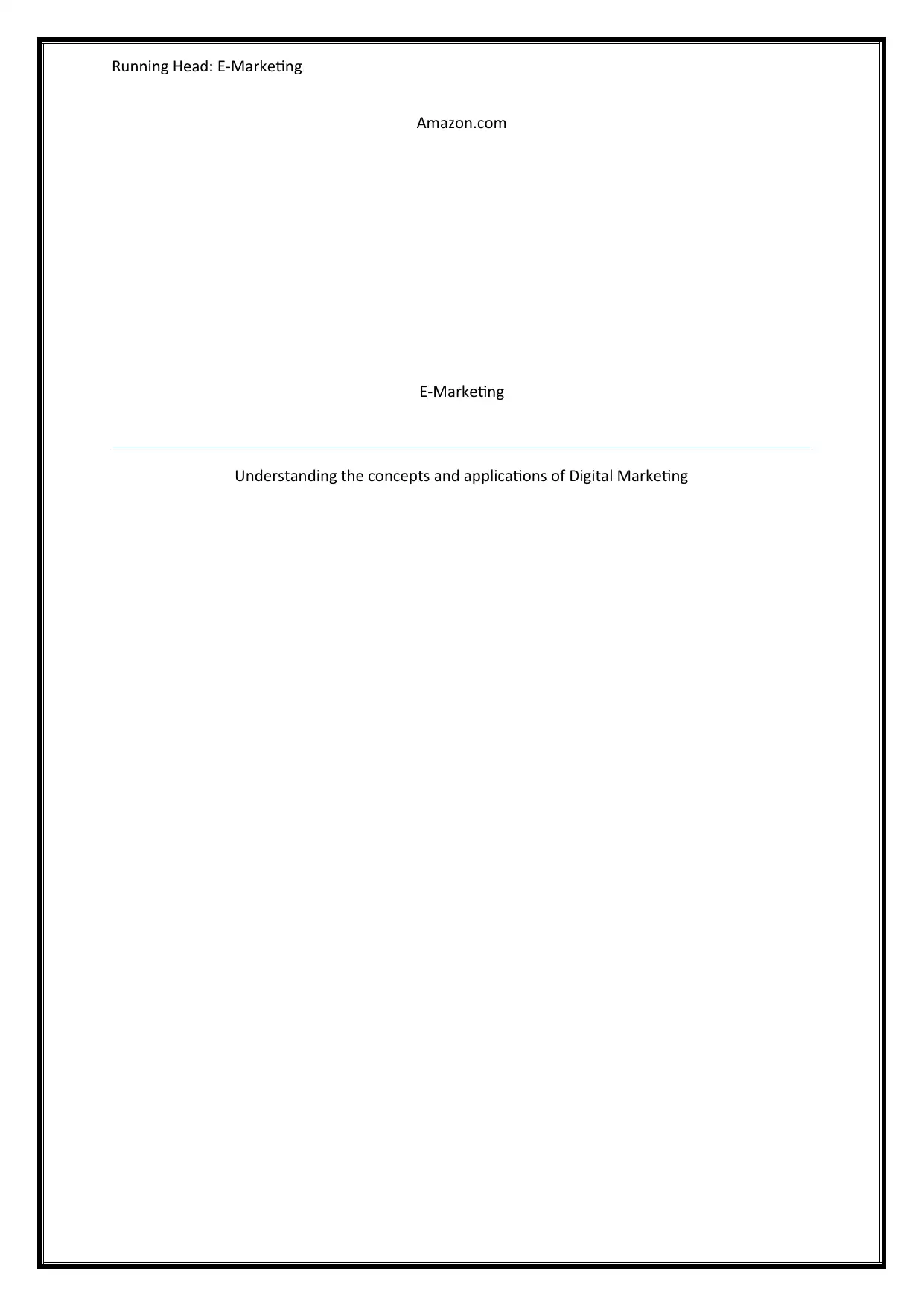
Running Head: E-Marketing
Amazon.com
E-Marketing
Understanding the concepts and applications of Digital Marketing
Amazon.com
E-Marketing
Understanding the concepts and applications of Digital Marketing
Paraphrase This Document
Need a fresh take? Get an instant paraphrase of this document with our AI Paraphraser
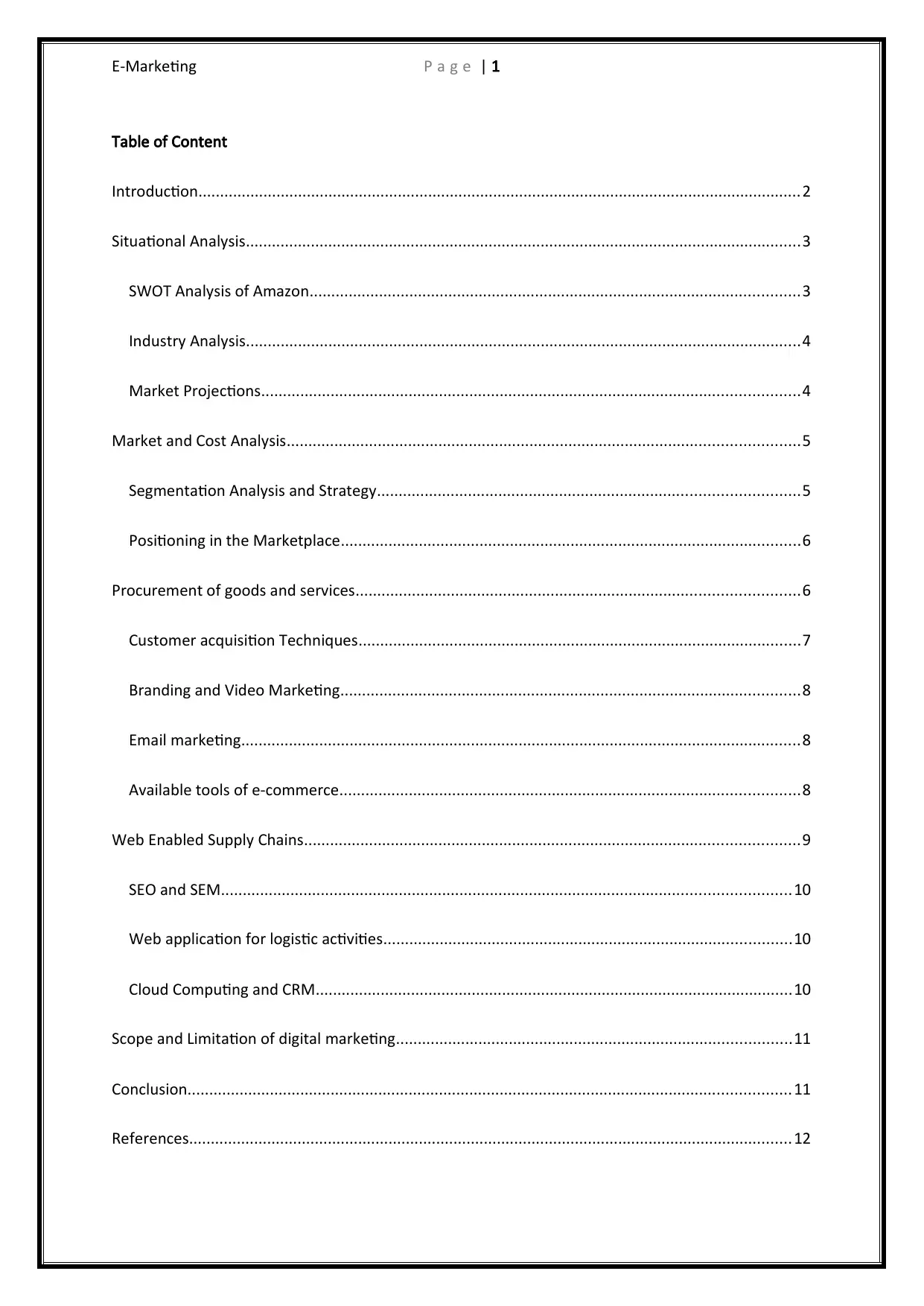
E-Marketing P a g e | 1
Table of Content
Introduction...........................................................................................................................................2
Situational Analysis................................................................................................................................3
SWOT Analysis of Amazon.................................................................................................................3
Industry Analysis................................................................................................................................4
Market Projections............................................................................................................................4
Market and Cost Analysis......................................................................................................................5
Segmentation Analysis and Strategy.................................................................................................5
Positioning in the Marketplace..........................................................................................................6
Procurement of goods and services......................................................................................................6
Customer acquisition Techniques......................................................................................................7
Branding and Video Marketing..........................................................................................................8
Email marketing.................................................................................................................................8
Available tools of e-commerce..........................................................................................................8
Web Enabled Supply Chains..................................................................................................................9
SEO and SEM...................................................................................................................................10
Web application for logistic activities..............................................................................................10
Cloud Computing and CRM..............................................................................................................10
Scope and Limitation of digital marketing...........................................................................................11
Conclusion...........................................................................................................................................11
References...........................................................................................................................................12
Table of Content
Introduction...........................................................................................................................................2
Situational Analysis................................................................................................................................3
SWOT Analysis of Amazon.................................................................................................................3
Industry Analysis................................................................................................................................4
Market Projections............................................................................................................................4
Market and Cost Analysis......................................................................................................................5
Segmentation Analysis and Strategy.................................................................................................5
Positioning in the Marketplace..........................................................................................................6
Procurement of goods and services......................................................................................................6
Customer acquisition Techniques......................................................................................................7
Branding and Video Marketing..........................................................................................................8
Email marketing.................................................................................................................................8
Available tools of e-commerce..........................................................................................................8
Web Enabled Supply Chains..................................................................................................................9
SEO and SEM...................................................................................................................................10
Web application for logistic activities..............................................................................................10
Cloud Computing and CRM..............................................................................................................10
Scope and Limitation of digital marketing...........................................................................................11
Conclusion...........................................................................................................................................11
References...........................................................................................................................................12

E-Marketing P a g e | 2
⊘ This is a preview!⊘
Do you want full access?
Subscribe today to unlock all pages.

Trusted by 1+ million students worldwide
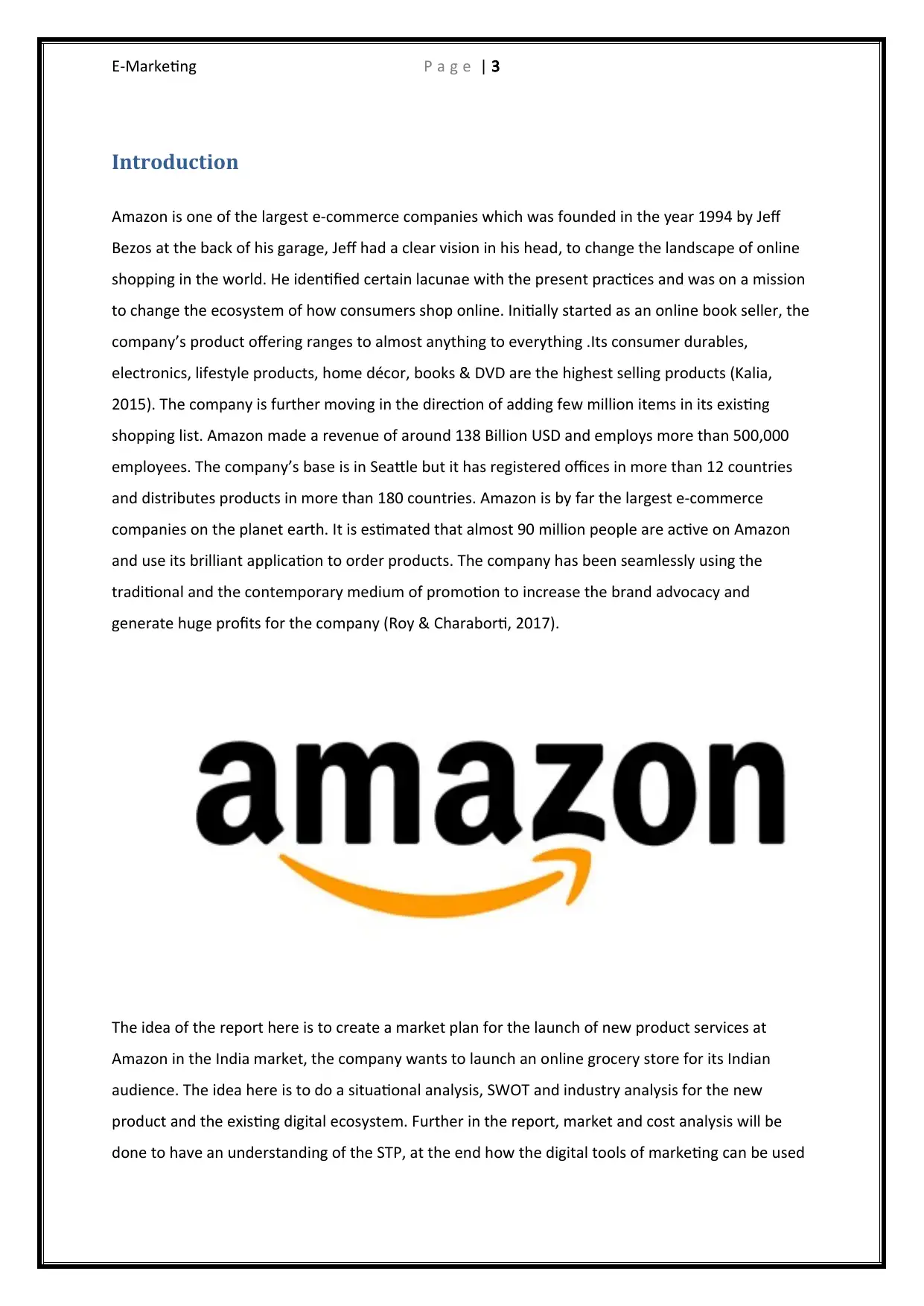
E-Marketing P a g e | 3
Introduction
Amazon is one of the largest e-commerce companies which was founded in the year 1994 by Jeff
Bezos at the back of his garage, Jeff had a clear vision in his head, to change the landscape of online
shopping in the world. He identified certain lacunae with the present practices and was on a mission
to change the ecosystem of how consumers shop online. Initially started as an online book seller, the
company’s product offering ranges to almost anything to everything .Its consumer durables,
electronics, lifestyle products, home décor, books & DVD are the highest selling products (Kalia,
2015). The company is further moving in the direction of adding few million items in its existing
shopping list. Amazon made a revenue of around 138 Billion USD and employs more than 500,000
employees. The company’s base is in Seattle but it has registered offices in more than 12 countries
and distributes products in more than 180 countries. Amazon is by far the largest e-commerce
companies on the planet earth. It is estimated that almost 90 million people are active on Amazon
and use its brilliant application to order products. The company has been seamlessly using the
traditional and the contemporary medium of promotion to increase the brand advocacy and
generate huge profits for the company (Roy & Charaborti, 2017).
The idea of the report here is to create a market plan for the launch of new product services at
Amazon in the India market, the company wants to launch an online grocery store for its Indian
audience. The idea here is to do a situational analysis, SWOT and industry analysis for the new
product and the existing digital ecosystem. Further in the report, market and cost analysis will be
done to have an understanding of the STP, at the end how the digital tools of marketing can be used
Introduction
Amazon is one of the largest e-commerce companies which was founded in the year 1994 by Jeff
Bezos at the back of his garage, Jeff had a clear vision in his head, to change the landscape of online
shopping in the world. He identified certain lacunae with the present practices and was on a mission
to change the ecosystem of how consumers shop online. Initially started as an online book seller, the
company’s product offering ranges to almost anything to everything .Its consumer durables,
electronics, lifestyle products, home décor, books & DVD are the highest selling products (Kalia,
2015). The company is further moving in the direction of adding few million items in its existing
shopping list. Amazon made a revenue of around 138 Billion USD and employs more than 500,000
employees. The company’s base is in Seattle but it has registered offices in more than 12 countries
and distributes products in more than 180 countries. Amazon is by far the largest e-commerce
companies on the planet earth. It is estimated that almost 90 million people are active on Amazon
and use its brilliant application to order products. The company has been seamlessly using the
traditional and the contemporary medium of promotion to increase the brand advocacy and
generate huge profits for the company (Roy & Charaborti, 2017).
The idea of the report here is to create a market plan for the launch of new product services at
Amazon in the India market, the company wants to launch an online grocery store for its Indian
audience. The idea here is to do a situational analysis, SWOT and industry analysis for the new
product and the existing digital ecosystem. Further in the report, market and cost analysis will be
done to have an understanding of the STP, at the end how the digital tools of marketing can be used
Paraphrase This Document
Need a fresh take? Get an instant paraphrase of this document with our AI Paraphraser
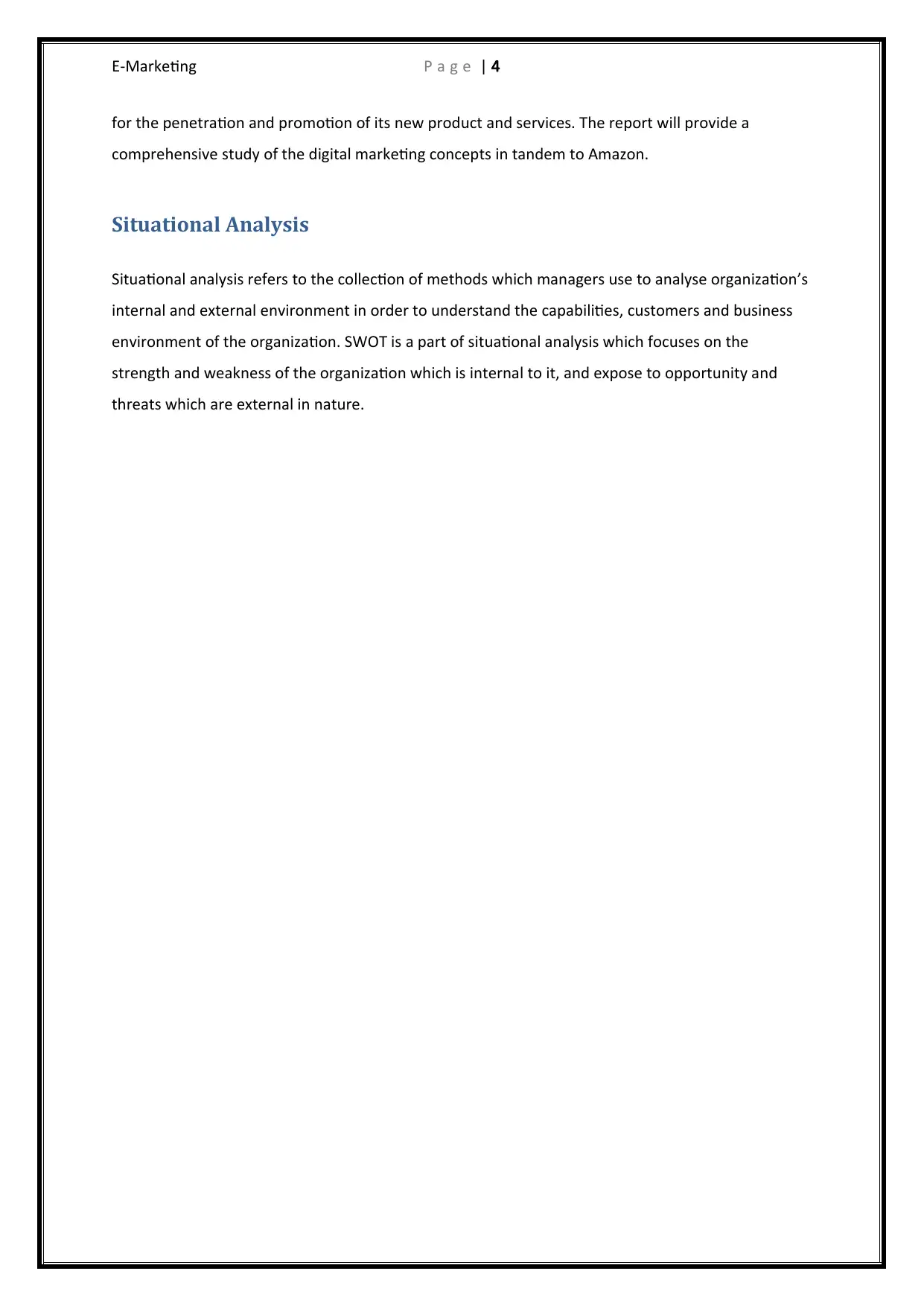
E-Marketing P a g e | 4
for the penetration and promotion of its new product and services. The report will provide a
comprehensive study of the digital marketing concepts in tandem to Amazon.
Situational Analysis
Situational analysis refers to the collection of methods which managers use to analyse organization’s
internal and external environment in order to understand the capabilities, customers and business
environment of the organization. SWOT is a part of situational analysis which focuses on the
strength and weakness of the organization which is internal to it, and expose to opportunity and
threats which are external in nature.
for the penetration and promotion of its new product and services. The report will provide a
comprehensive study of the digital marketing concepts in tandem to Amazon.
Situational Analysis
Situational analysis refers to the collection of methods which managers use to analyse organization’s
internal and external environment in order to understand the capabilities, customers and business
environment of the organization. SWOT is a part of situational analysis which focuses on the
strength and weakness of the organization which is internal to it, and expose to opportunity and
threats which are external in nature.
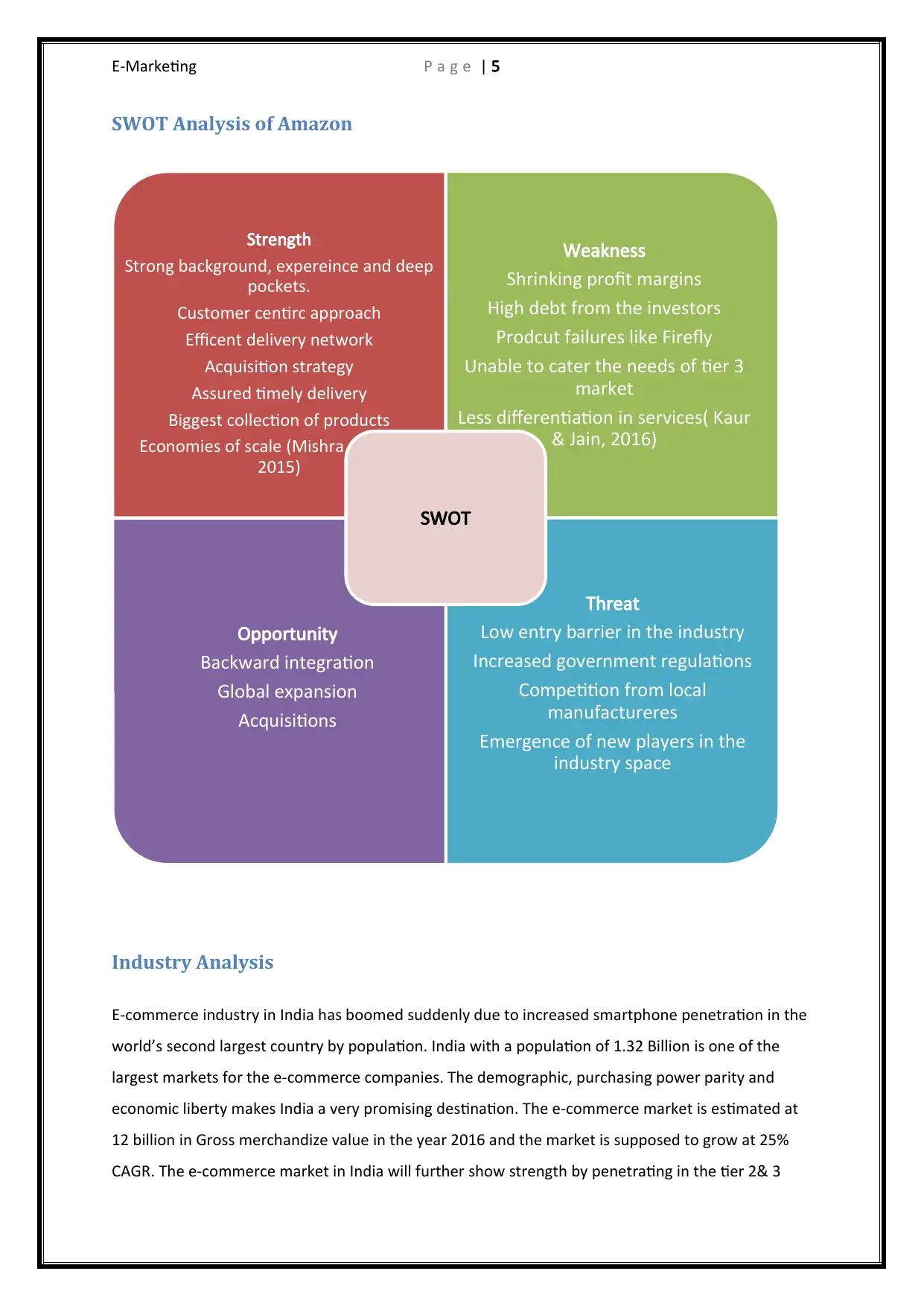
E-Marketing P a g e | 5
SWOT Analysis of Amazon
Industry Analysis
E-commerce industry in India has boomed suddenly due to increased smartphone penetration in the
world’s second largest country by population. India with a population of 1.32 Billion is one of the
largest markets for the e-commerce companies. The demographic, purchasing power parity and
economic liberty makes India a very promising destination. The e-commerce market is estimated at
12 billion in Gross merchandize value in the year 2016 and the market is supposed to grow at 25%
CAGR. The e-commerce market in India will further show strength by penetrating in the tier 2& 3
Strength
Strong background, expereince and deep
pockets.
Customer centirc approach
Efficent delivery network
Acquisition strategy
Assured timely delivery
Biggest collection of products
Economies of scale (Mishra & Kotkar,
2015)
Weakness
Shrinking profit margins
High debt from the investors
Prodcut failures like Firefly
Unable to cater the needs of tier 3
market
Less differentiation in services( Kaur
& Jain, 2016)
Opportunity
Backward integration
Global expansion
Acquisitions
Threat
Low entry barrier in the industry
Increased government regulations
Competition from local
manufactureres
Emergence of new players in the
industry space
SWOT
SWOT Analysis of Amazon
Industry Analysis
E-commerce industry in India has boomed suddenly due to increased smartphone penetration in the
world’s second largest country by population. India with a population of 1.32 Billion is one of the
largest markets for the e-commerce companies. The demographic, purchasing power parity and
economic liberty makes India a very promising destination. The e-commerce market is estimated at
12 billion in Gross merchandize value in the year 2016 and the market is supposed to grow at 25%
CAGR. The e-commerce market in India will further show strength by penetrating in the tier 2& 3
Strength
Strong background, expereince and deep
pockets.
Customer centirc approach
Efficent delivery network
Acquisition strategy
Assured timely delivery
Biggest collection of products
Economies of scale (Mishra & Kotkar,
2015)
Weakness
Shrinking profit margins
High debt from the investors
Prodcut failures like Firefly
Unable to cater the needs of tier 3
market
Less differentiation in services( Kaur
& Jain, 2016)
Opportunity
Backward integration
Global expansion
Acquisitions
Threat
Low entry barrier in the industry
Increased government regulations
Competition from local
manufactureres
Emergence of new players in the
industry space
SWOT
⊘ This is a preview!⊘
Do you want full access?
Subscribe today to unlock all pages.

Trusted by 1+ million students worldwide
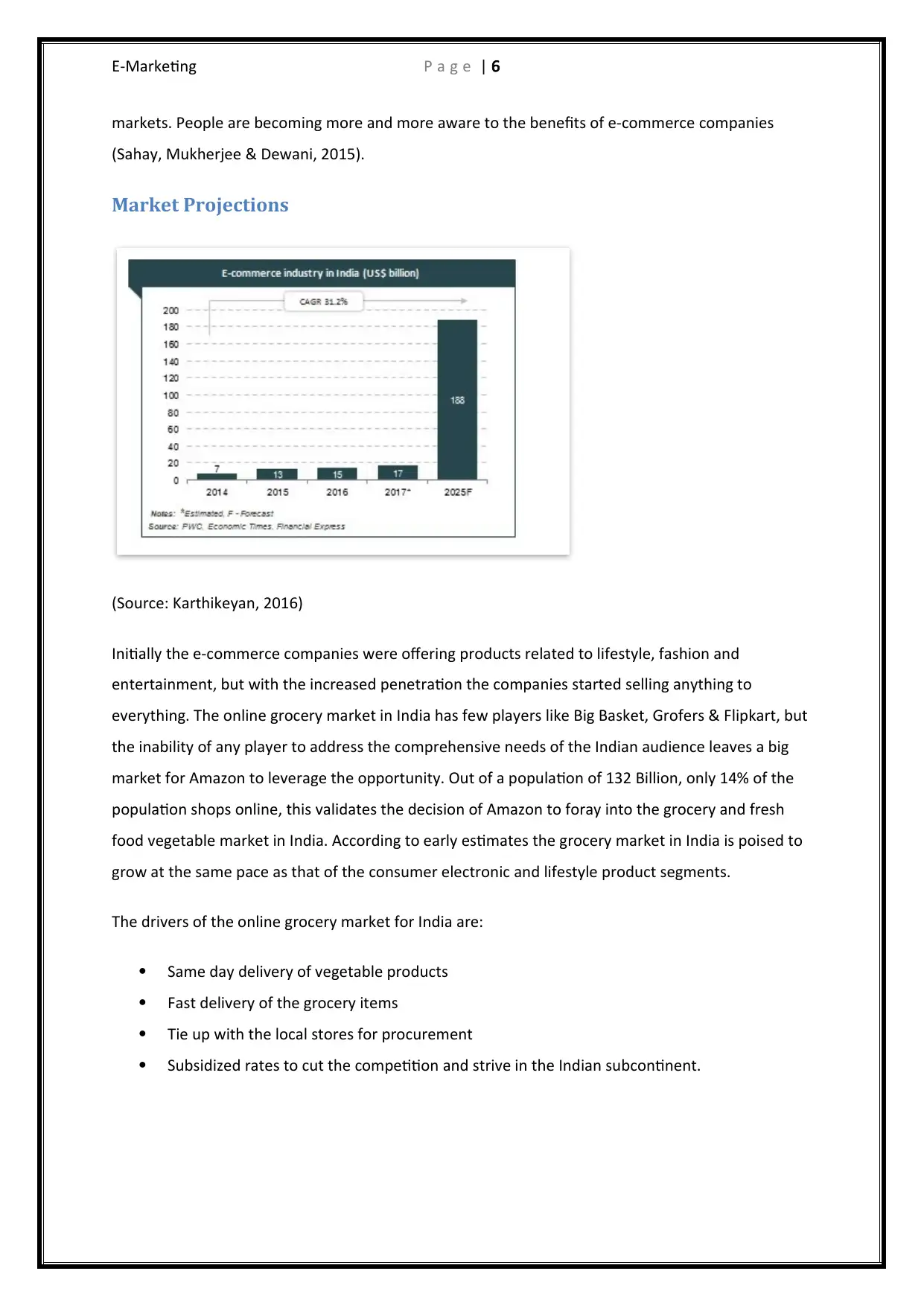
E-Marketing P a g e | 6
markets. People are becoming more and more aware to the benefits of e-commerce companies
(Sahay, Mukherjee & Dewani, 2015).
Market Projections
(Source: Karthikeyan, 2016)
Initially the e-commerce companies were offering products related to lifestyle, fashion and
entertainment, but with the increased penetration the companies started selling anything to
everything. The online grocery market in India has few players like Big Basket, Grofers & Flipkart, but
the inability of any player to address the comprehensive needs of the Indian audience leaves a big
market for Amazon to leverage the opportunity. Out of a population of 132 Billion, only 14% of the
population shops online, this validates the decision of Amazon to foray into the grocery and fresh
food vegetable market in India. According to early estimates the grocery market in India is poised to
grow at the same pace as that of the consumer electronic and lifestyle product segments.
The drivers of the online grocery market for India are:
Same day delivery of vegetable products
Fast delivery of the grocery items
Tie up with the local stores for procurement
Subsidized rates to cut the competition and strive in the Indian subcontinent.
markets. People are becoming more and more aware to the benefits of e-commerce companies
(Sahay, Mukherjee & Dewani, 2015).
Market Projections
(Source: Karthikeyan, 2016)
Initially the e-commerce companies were offering products related to lifestyle, fashion and
entertainment, but with the increased penetration the companies started selling anything to
everything. The online grocery market in India has few players like Big Basket, Grofers & Flipkart, but
the inability of any player to address the comprehensive needs of the Indian audience leaves a big
market for Amazon to leverage the opportunity. Out of a population of 132 Billion, only 14% of the
population shops online, this validates the decision of Amazon to foray into the grocery and fresh
food vegetable market in India. According to early estimates the grocery market in India is poised to
grow at the same pace as that of the consumer electronic and lifestyle product segments.
The drivers of the online grocery market for India are:
Same day delivery of vegetable products
Fast delivery of the grocery items
Tie up with the local stores for procurement
Subsidized rates to cut the competition and strive in the Indian subcontinent.
Paraphrase This Document
Need a fresh take? Get an instant paraphrase of this document with our AI Paraphraser
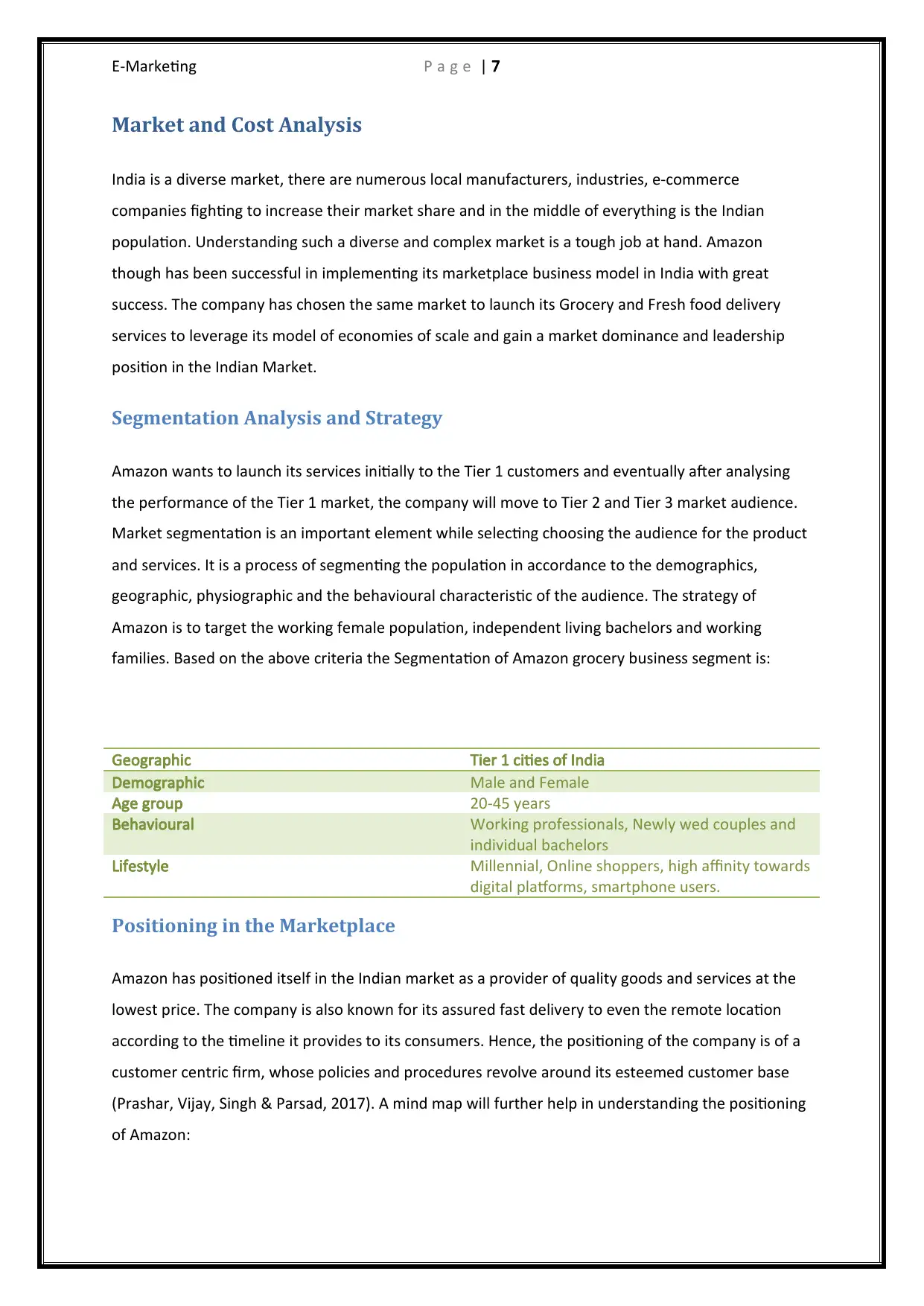
E-Marketing P a g e | 7
Market and Cost Analysis
India is a diverse market, there are numerous local manufacturers, industries, e-commerce
companies fighting to increase their market share and in the middle of everything is the Indian
population. Understanding such a diverse and complex market is a tough job at hand. Amazon
though has been successful in implementing its marketplace business model in India with great
success. The company has chosen the same market to launch its Grocery and Fresh food delivery
services to leverage its model of economies of scale and gain a market dominance and leadership
position in the Indian Market.
Segmentation Analysis and Strategy
Amazon wants to launch its services initially to the Tier 1 customers and eventually after analysing
the performance of the Tier 1 market, the company will move to Tier 2 and Tier 3 market audience.
Market segmentation is an important element while selecting choosing the audience for the product
and services. It is a process of segmenting the population in accordance to the demographics,
geographic, physiographic and the behavioural characteristic of the audience. The strategy of
Amazon is to target the working female population, independent living bachelors and working
families. Based on the above criteria the Segmentation of Amazon grocery business segment is:
Geographic Tier 1 cities of India
Demographic Male and Female
Age group 20-45 years
Behavioural Working professionals, Newly wed couples and
individual bachelors
Lifestyle Millennial, Online shoppers, high affinity towards
digital platforms, smartphone users.
Positioning in the Marketplace
Amazon has positioned itself in the Indian market as a provider of quality goods and services at the
lowest price. The company is also known for its assured fast delivery to even the remote location
according to the timeline it provides to its consumers. Hence, the positioning of the company is of a
customer centric firm, whose policies and procedures revolve around its esteemed customer base
(Prashar, Vijay, Singh & Parsad, 2017). A mind map will further help in understanding the positioning
of Amazon:
Market and Cost Analysis
India is a diverse market, there are numerous local manufacturers, industries, e-commerce
companies fighting to increase their market share and in the middle of everything is the Indian
population. Understanding such a diverse and complex market is a tough job at hand. Amazon
though has been successful in implementing its marketplace business model in India with great
success. The company has chosen the same market to launch its Grocery and Fresh food delivery
services to leverage its model of economies of scale and gain a market dominance and leadership
position in the Indian Market.
Segmentation Analysis and Strategy
Amazon wants to launch its services initially to the Tier 1 customers and eventually after analysing
the performance of the Tier 1 market, the company will move to Tier 2 and Tier 3 market audience.
Market segmentation is an important element while selecting choosing the audience for the product
and services. It is a process of segmenting the population in accordance to the demographics,
geographic, physiographic and the behavioural characteristic of the audience. The strategy of
Amazon is to target the working female population, independent living bachelors and working
families. Based on the above criteria the Segmentation of Amazon grocery business segment is:
Geographic Tier 1 cities of India
Demographic Male and Female
Age group 20-45 years
Behavioural Working professionals, Newly wed couples and
individual bachelors
Lifestyle Millennial, Online shoppers, high affinity towards
digital platforms, smartphone users.
Positioning in the Marketplace
Amazon has positioned itself in the Indian market as a provider of quality goods and services at the
lowest price. The company is also known for its assured fast delivery to even the remote location
according to the timeline it provides to its consumers. Hence, the positioning of the company is of a
customer centric firm, whose policies and procedures revolve around its esteemed customer base
(Prashar, Vijay, Singh & Parsad, 2017). A mind map will further help in understanding the positioning
of Amazon:
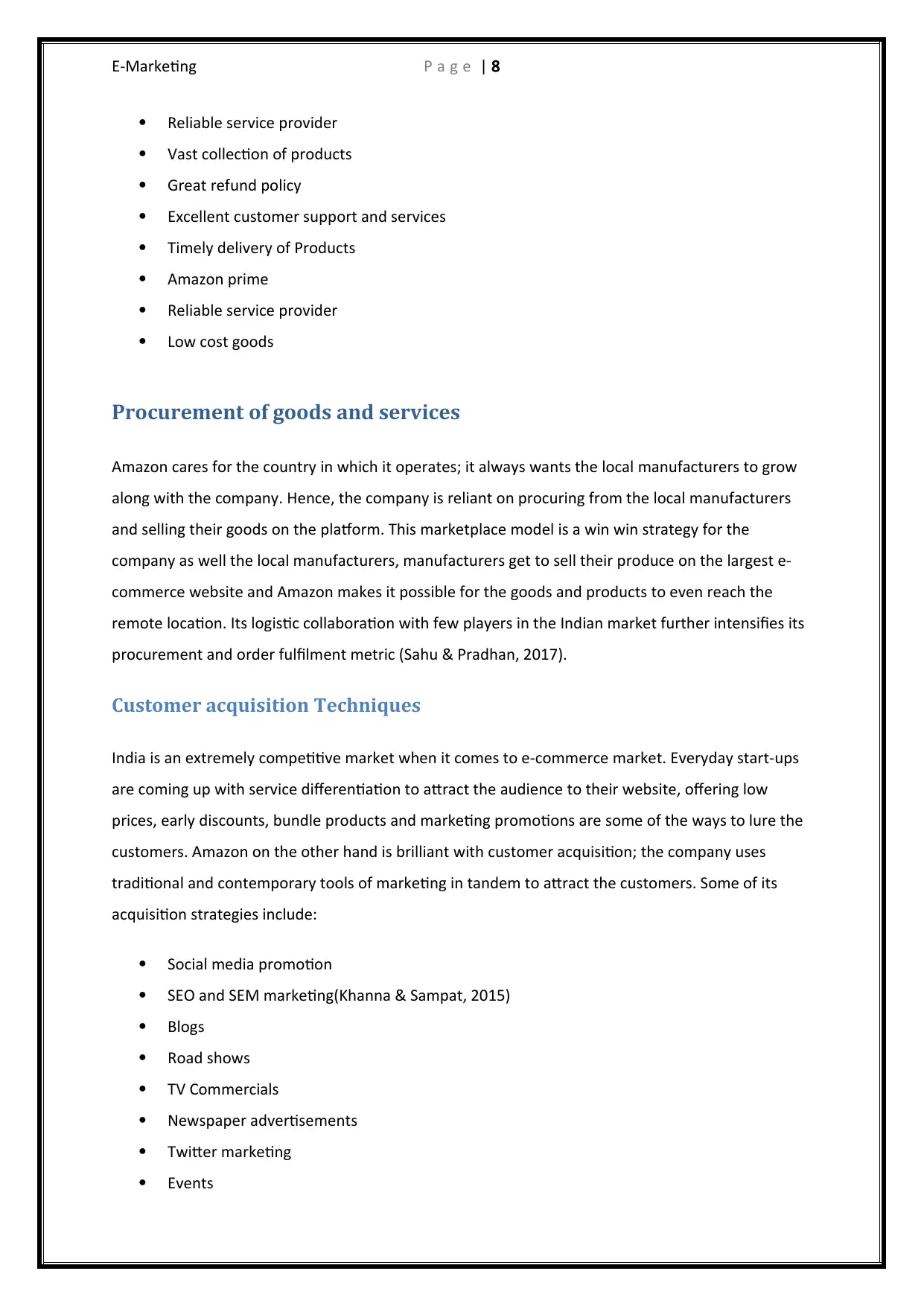
E-Marketing P a g e | 8
Reliable service provider
Vast collection of products
Great refund policy
Excellent customer support and services
Timely delivery of Products
Amazon prime
Reliable service provider
Low cost goods
Procurement of goods and services
Amazon cares for the country in which it operates; it always wants the local manufacturers to grow
along with the company. Hence, the company is reliant on procuring from the local manufacturers
and selling their goods on the platform. This marketplace model is a win win strategy for the
company as well the local manufacturers, manufacturers get to sell their produce on the largest e-
commerce website and Amazon makes it possible for the goods and products to even reach the
remote location. Its logistic collaboration with few players in the Indian market further intensifies its
procurement and order fulfilment metric (Sahu & Pradhan, 2017).
Customer acquisition Techniques
India is an extremely competitive market when it comes to e-commerce market. Everyday start-ups
are coming up with service differentiation to attract the audience to their website, offering low
prices, early discounts, bundle products and marketing promotions are some of the ways to lure the
customers. Amazon on the other hand is brilliant with customer acquisition; the company uses
traditional and contemporary tools of marketing in tandem to attract the customers. Some of its
acquisition strategies include:
Social media promotion
SEO and SEM marketing(Khanna & Sampat, 2015)
Blogs
Road shows
TV Commercials
Newspaper advertisements
Twitter marketing
Events
Reliable service provider
Vast collection of products
Great refund policy
Excellent customer support and services
Timely delivery of Products
Amazon prime
Reliable service provider
Low cost goods
Procurement of goods and services
Amazon cares for the country in which it operates; it always wants the local manufacturers to grow
along with the company. Hence, the company is reliant on procuring from the local manufacturers
and selling their goods on the platform. This marketplace model is a win win strategy for the
company as well the local manufacturers, manufacturers get to sell their produce on the largest e-
commerce website and Amazon makes it possible for the goods and products to even reach the
remote location. Its logistic collaboration with few players in the Indian market further intensifies its
procurement and order fulfilment metric (Sahu & Pradhan, 2017).
Customer acquisition Techniques
India is an extremely competitive market when it comes to e-commerce market. Everyday start-ups
are coming up with service differentiation to attract the audience to their website, offering low
prices, early discounts, bundle products and marketing promotions are some of the ways to lure the
customers. Amazon on the other hand is brilliant with customer acquisition; the company uses
traditional and contemporary tools of marketing in tandem to attract the customers. Some of its
acquisition strategies include:
Social media promotion
SEO and SEM marketing(Khanna & Sampat, 2015)
Blogs
Road shows
TV Commercials
Newspaper advertisements
Twitter marketing
Events
⊘ This is a preview!⊘
Do you want full access?
Subscribe today to unlock all pages.

Trusted by 1+ million students worldwide
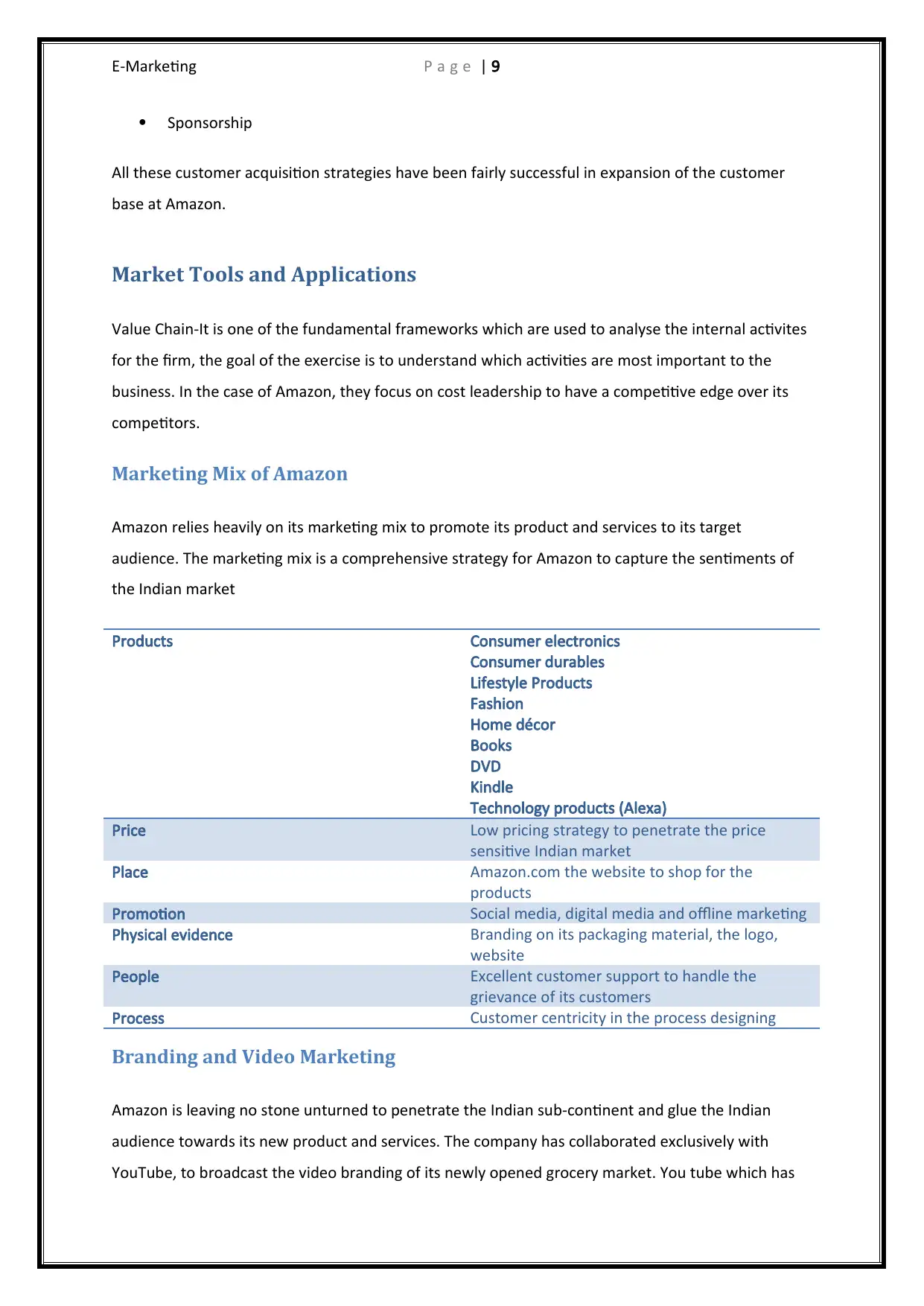
E-Marketing P a g e | 9
Sponsorship
All these customer acquisition strategies have been fairly successful in expansion of the customer
base at Amazon.
Market Tools and Applications
Value Chain-It is one of the fundamental frameworks which are used to analyse the internal activites
for the firm, the goal of the exercise is to understand which activities are most important to the
business. In the case of Amazon, they focus on cost leadership to have a competitive edge over its
competitors.
Marketing Mix of Amazon
Amazon relies heavily on its marketing mix to promote its product and services to its target
audience. The marketing mix is a comprehensive strategy for Amazon to capture the sentiments of
the Indian market
Products Consumer electronics
Consumer durables
Lifestyle Products
Fashion
Home décor
Books
DVD
Kindle
Technology products (Alexa)
Price Low pricing strategy to penetrate the price
sensitive Indian market
Place Amazon.com the website to shop for the
products
Promotion Social media, digital media and offline marketing
Physical evidence Branding on its packaging material, the logo,
website
People Excellent customer support to handle the
grievance of its customers
Process Customer centricity in the process designing
Branding and Video Marketing
Amazon is leaving no stone unturned to penetrate the Indian sub-continent and glue the Indian
audience towards its new product and services. The company has collaborated exclusively with
YouTube, to broadcast the video branding of its newly opened grocery market. You tube which has
Sponsorship
All these customer acquisition strategies have been fairly successful in expansion of the customer
base at Amazon.
Market Tools and Applications
Value Chain-It is one of the fundamental frameworks which are used to analyse the internal activites
for the firm, the goal of the exercise is to understand which activities are most important to the
business. In the case of Amazon, they focus on cost leadership to have a competitive edge over its
competitors.
Marketing Mix of Amazon
Amazon relies heavily on its marketing mix to promote its product and services to its target
audience. The marketing mix is a comprehensive strategy for Amazon to capture the sentiments of
the Indian market
Products Consumer electronics
Consumer durables
Lifestyle Products
Fashion
Home décor
Books
DVD
Kindle
Technology products (Alexa)
Price Low pricing strategy to penetrate the price
sensitive Indian market
Place Amazon.com the website to shop for the
products
Promotion Social media, digital media and offline marketing
Physical evidence Branding on its packaging material, the logo,
website
People Excellent customer support to handle the
grievance of its customers
Process Customer centricity in the process designing
Branding and Video Marketing
Amazon is leaving no stone unturned to penetrate the Indian sub-continent and glue the Indian
audience towards its new product and services. The company has collaborated exclusively with
YouTube, to broadcast the video branding of its newly opened grocery market. You tube which has
Paraphrase This Document
Need a fresh take? Get an instant paraphrase of this document with our AI Paraphraser
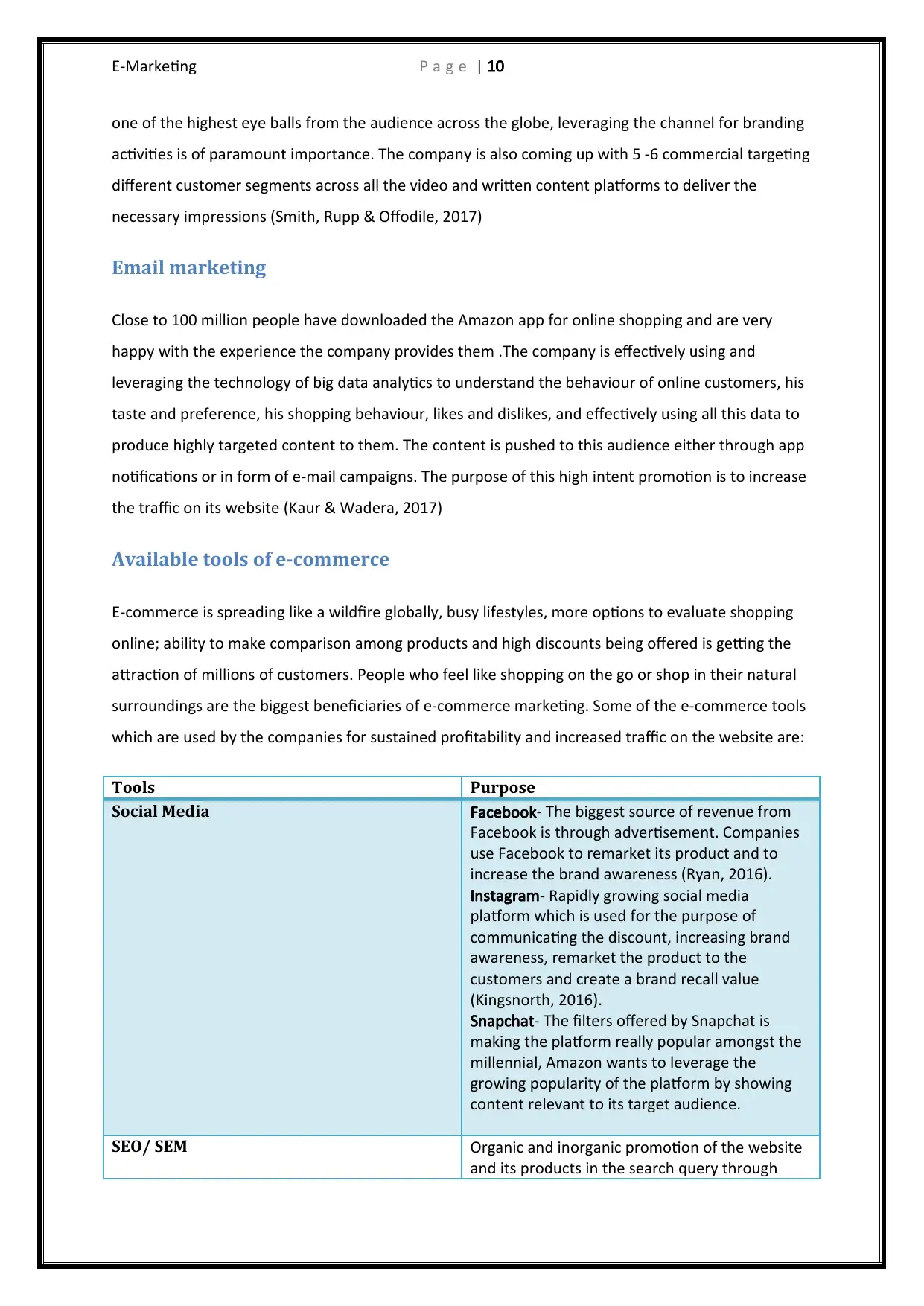
E-Marketing P a g e | 10
one of the highest eye balls from the audience across the globe, leveraging the channel for branding
activities is of paramount importance. The company is also coming up with 5 -6 commercial targeting
different customer segments across all the video and written content platforms to deliver the
necessary impressions (Smith, Rupp & Offodile, 2017)
Email marketing
Close to 100 million people have downloaded the Amazon app for online shopping and are very
happy with the experience the company provides them .The company is effectively using and
leveraging the technology of big data analytics to understand the behaviour of online customers, his
taste and preference, his shopping behaviour, likes and dislikes, and effectively using all this data to
produce highly targeted content to them. The content is pushed to this audience either through app
notifications or in form of e-mail campaigns. The purpose of this high intent promotion is to increase
the traffic on its website (Kaur & Wadera, 2017)
Available tools of e-commerce
E-commerce is spreading like a wildfire globally, busy lifestyles, more options to evaluate shopping
online; ability to make comparison among products and high discounts being offered is getting the
attraction of millions of customers. People who feel like shopping on the go or shop in their natural
surroundings are the biggest beneficiaries of e-commerce marketing. Some of the e-commerce tools
which are used by the companies for sustained profitability and increased traffic on the website are:
Tools Purpose
Social Media Facebook- The biggest source of revenue from
Facebook is through advertisement. Companies
use Facebook to remarket its product and to
increase the brand awareness (Ryan, 2016).
Instagram- Rapidly growing social media
platform which is used for the purpose of
communicating the discount, increasing brand
awareness, remarket the product to the
customers and create a brand recall value
(Kingsnorth, 2016).
Snapchat- The filters offered by Snapchat is
making the platform really popular amongst the
millennial, Amazon wants to leverage the
growing popularity of the platform by showing
content relevant to its target audience.
SEO/ SEM Organic and inorganic promotion of the website
and its products in the search query through
one of the highest eye balls from the audience across the globe, leveraging the channel for branding
activities is of paramount importance. The company is also coming up with 5 -6 commercial targeting
different customer segments across all the video and written content platforms to deliver the
necessary impressions (Smith, Rupp & Offodile, 2017)
Email marketing
Close to 100 million people have downloaded the Amazon app for online shopping and are very
happy with the experience the company provides them .The company is effectively using and
leveraging the technology of big data analytics to understand the behaviour of online customers, his
taste and preference, his shopping behaviour, likes and dislikes, and effectively using all this data to
produce highly targeted content to them. The content is pushed to this audience either through app
notifications or in form of e-mail campaigns. The purpose of this high intent promotion is to increase
the traffic on its website (Kaur & Wadera, 2017)
Available tools of e-commerce
E-commerce is spreading like a wildfire globally, busy lifestyles, more options to evaluate shopping
online; ability to make comparison among products and high discounts being offered is getting the
attraction of millions of customers. People who feel like shopping on the go or shop in their natural
surroundings are the biggest beneficiaries of e-commerce marketing. Some of the e-commerce tools
which are used by the companies for sustained profitability and increased traffic on the website are:
Tools Purpose
Social Media Facebook- The biggest source of revenue from
Facebook is through advertisement. Companies
use Facebook to remarket its product and to
increase the brand awareness (Ryan, 2016).
Instagram- Rapidly growing social media
platform which is used for the purpose of
communicating the discount, increasing brand
awareness, remarket the product to the
customers and create a brand recall value
(Kingsnorth, 2016).
Snapchat- The filters offered by Snapchat is
making the platform really popular amongst the
millennial, Amazon wants to leverage the
growing popularity of the platform by showing
content relevant to its target audience.
SEO/ SEM Organic and inorganic promotion of the website
and its products in the search query through
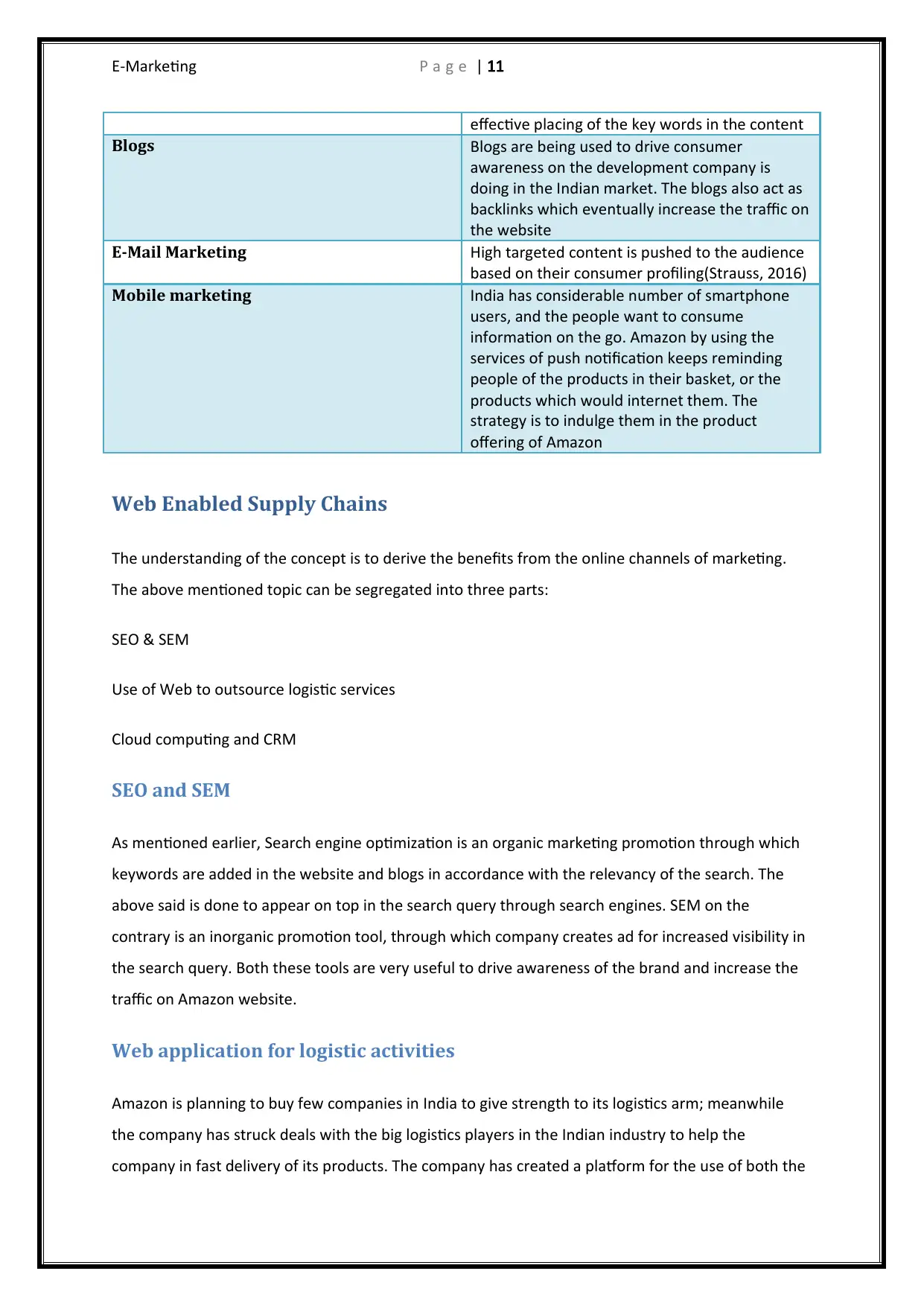
E-Marketing P a g e | 11
effective placing of the key words in the content
Blogs Blogs are being used to drive consumer
awareness on the development company is
doing in the Indian market. The blogs also act as
backlinks which eventually increase the traffic on
the website
E-Mail Marketing High targeted content is pushed to the audience
based on their consumer profiling(Strauss, 2016)
Mobile marketing India has considerable number of smartphone
users, and the people want to consume
information on the go. Amazon by using the
services of push notification keeps reminding
people of the products in their basket, or the
products which would internet them. The
strategy is to indulge them in the product
offering of Amazon
Web Enabled Supply Chains
The understanding of the concept is to derive the benefits from the online channels of marketing.
The above mentioned topic can be segregated into three parts:
SEO & SEM
Use of Web to outsource logistic services
Cloud computing and CRM
SEO and SEM
As mentioned earlier, Search engine optimization is an organic marketing promotion through which
keywords are added in the website and blogs in accordance with the relevancy of the search. The
above said is done to appear on top in the search query through search engines. SEM on the
contrary is an inorganic promotion tool, through which company creates ad for increased visibility in
the search query. Both these tools are very useful to drive awareness of the brand and increase the
traffic on Amazon website.
Web application for logistic activities
Amazon is planning to buy few companies in India to give strength to its logistics arm; meanwhile
the company has struck deals with the big logistics players in the Indian industry to help the
company in fast delivery of its products. The company has created a platform for the use of both the
effective placing of the key words in the content
Blogs Blogs are being used to drive consumer
awareness on the development company is
doing in the Indian market. The blogs also act as
backlinks which eventually increase the traffic on
the website
E-Mail Marketing High targeted content is pushed to the audience
based on their consumer profiling(Strauss, 2016)
Mobile marketing India has considerable number of smartphone
users, and the people want to consume
information on the go. Amazon by using the
services of push notification keeps reminding
people of the products in their basket, or the
products which would internet them. The
strategy is to indulge them in the product
offering of Amazon
Web Enabled Supply Chains
The understanding of the concept is to derive the benefits from the online channels of marketing.
The above mentioned topic can be segregated into three parts:
SEO & SEM
Use of Web to outsource logistic services
Cloud computing and CRM
SEO and SEM
As mentioned earlier, Search engine optimization is an organic marketing promotion through which
keywords are added in the website and blogs in accordance with the relevancy of the search. The
above said is done to appear on top in the search query through search engines. SEM on the
contrary is an inorganic promotion tool, through which company creates ad for increased visibility in
the search query. Both these tools are very useful to drive awareness of the brand and increase the
traffic on Amazon website.
Web application for logistic activities
Amazon is planning to buy few companies in India to give strength to its logistics arm; meanwhile
the company has struck deals with the big logistics players in the Indian industry to help the
company in fast delivery of its products. The company has created a platform for the use of both the
⊘ This is a preview!⊘
Do you want full access?
Subscribe today to unlock all pages.

Trusted by 1+ million students worldwide
1 out of 15
Related Documents
Your All-in-One AI-Powered Toolkit for Academic Success.
+13062052269
info@desklib.com
Available 24*7 on WhatsApp / Email
![[object Object]](/_next/static/media/star-bottom.7253800d.svg)
Unlock your academic potential
Copyright © 2020–2025 A2Z Services. All Rights Reserved. Developed and managed by ZUCOL.





